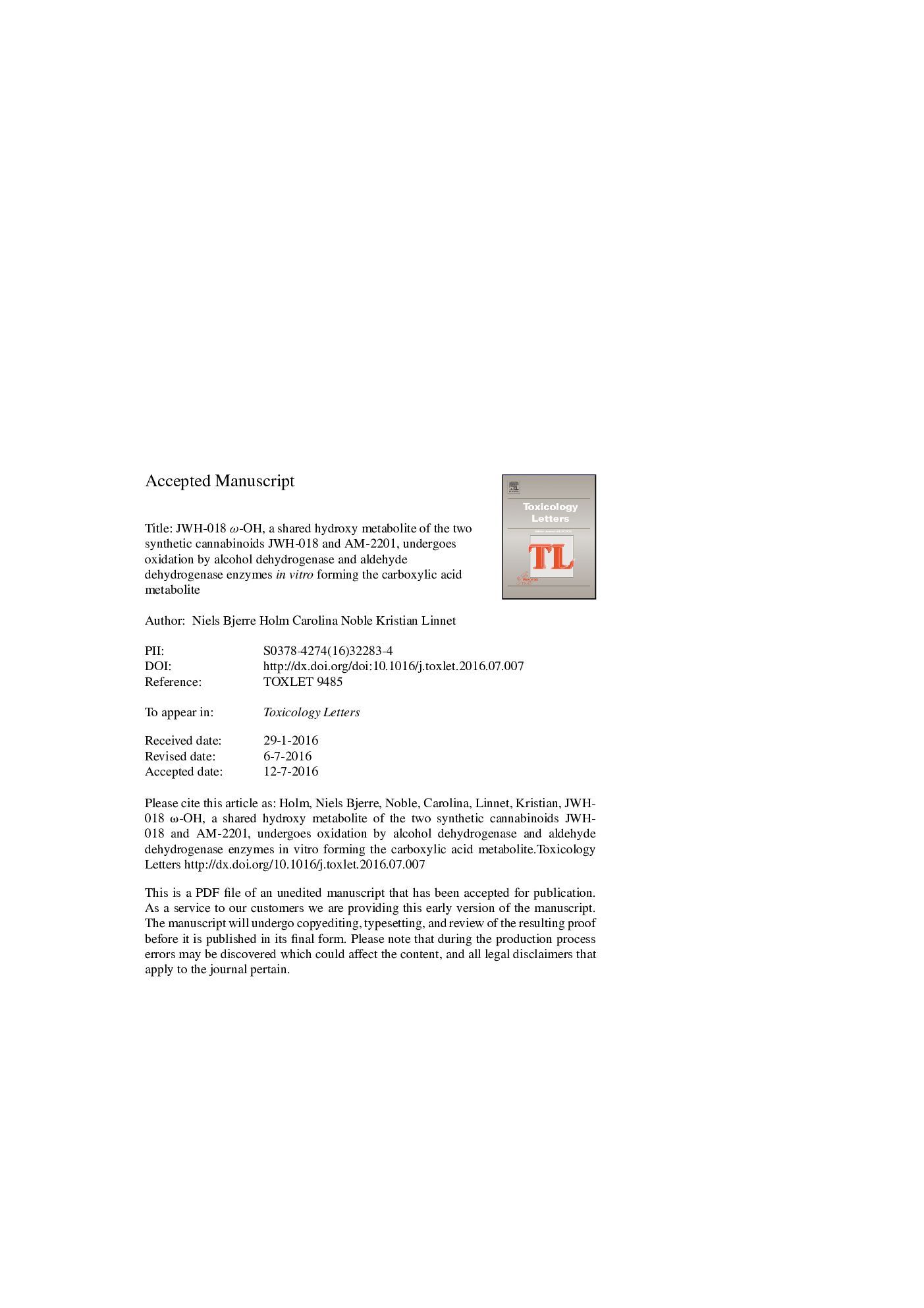| کد مقاله | کد نشریه | سال انتشار | مقاله انگلیسی | نسخه تمام متن |
|---|---|---|---|---|
| 5859686 | 1562614 | 2016 | 27 صفحه PDF | دانلود رایگان |
عنوان انگلیسی مقاله ISI
JWH-018 Ï-OH, a shared hydroxy metabolite of the two synthetic cannabinoids JWH-018 and AM-2201, undergoes oxidation by alcohol dehydrogenase and aldehyde dehydrogenase enzymes in vitro forming the carboxylic acid metabolite
دانلود مقاله + سفارش ترجمه
دانلود مقاله ISI انگلیسی
رایگان برای ایرانیان
کلمات کلیدی
ALDHHLMtetrahydrocannabinolRPAHLCUHPLCADHJWH-018EMCDDACyPTHCESIXanthine oxidase - زانتین اکسیدازSynthetic cannabinoids - Canabinoids مصنوعیLC–MS - LC-MSNPs - NP هاaldehyde oxidase - آلدئید اکسیدازaldehyde dehydrogenase - آلدئید دهیدروژنازAlcohol dehydrogenase - الکل دهیدروژنازAlcohol oxidation - اکسید کردن الکل، اکسایش الکلrelative peak area - سطح پیک نسبیhuman liver cytosol - سیتوزول کبدی انسانیCytochrome P450 - سیتوکروم پی۴۵۰liquid chromatography–mass spectrometry - طیف سنجی جرم کروماتوگرافی مایعNew psychoactive substance - ماده روانگردان جدیدIn vitro metabolism - متابولیسم درون بدنEuropean Monitoring Centre for Drugs and Drug Addiction - مرکز نظارت بر اروپا برای مواد مخدر و اعتیاد به مواد مخدرEIC - مهندسانUltra-high performance liquid chromatography - کروماتوگرافی مایع با کارایی فوق العاده بالاextracted ion chromatogram - کروماتوگرافی یون استخراج شدهelectrospray ionization - یونیزاسیون الکترو اسپری
موضوعات مرتبط
علوم زیستی و بیوفناوری
علوم محیط زیست
بهداشت، سم شناسی و جهش زایی
پیش نمایش صفحه اول مقاله

چکیده انگلیسی
Synthetic cannabinoids are new psychoactive substances (NPS) acting as agonists at the cannabinoid receptors. The aminoalkylindole-type synthetic cannabinoid naphthalen-1-yl-(1-pentylindol-3-yl)methanone (JWH-018) was among the first to appear on the illicit drug market and its metabolism has been extensively investigated. The N-pentyl side chain is a major site of human cytochrome P450 (CYP)-mediated oxidative metabolism, and the Ï-carboxylic acid metabolite appears to be a major in vivo human urinary metabolite. This metabolite is, however, not formed to any significant extent in human liver microsomal (HLM) incubations raising the possibility that the discrepancy is due to involvement of cytosolic enzymes. Here we demonstrate in incubations with human liver cytosol (HLC), that JWH-018 Ï-OH, but not the JWH-018 parent compound, is a substrate for nicotinamide adenine dinucleotide (NAD+)-dependent alcohol dehydrogenase (ADH) and aldehyde dehydrogenase (ALDH) enzymes. The sole end-product identified in HLC was the JWH-018 Ï-COOH metabolite, while trapping tests with methoxyamine proved the presence of the aldehyde intermediate. ADH/ALDH and UDP-glucuronosyl-transferases (UGT) enzymes may therefore both act on the JWH-018 Ï-OH substrate. Finally, we note that for [1-(5-fluoropentyl)indol-3-yl]-naphthalen-1-yl-methanone (AM-2201), the Ï-fluorinated analog of JWH-018, a high amount of JWH-018 Ï-OH was formed in HLM incubated without NADPH, suggesting that the oxidative defluorination is efficiently catalyzed by non-CYP enzyme(s). The pathway presented here may therefore be especially important for N-(5-fluoropentyl) substituted synthetic cannabinoids, because the oxidative defluorination can occur even if the CYP-mediated metabolism preferentially takes place on other parts of the molecule than the N-alkyl side chain. Controlled clinical studies in humans are ultimately required to demonstrate the in vivo importance of the oxidation pathway presented here.
ناشر
Database: Elsevier - ScienceDirect (ساینس دایرکت)
Journal: Toxicology Letters - Volume 259, 30 September 2016, Pages 35-43
Journal: Toxicology Letters - Volume 259, 30 September 2016, Pages 35-43
نویسندگان
Niels Bjerre Holm, Carolina Noble, Kristian Linnet,